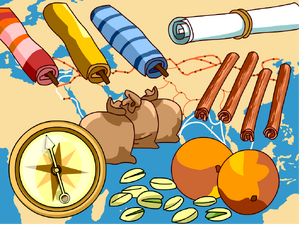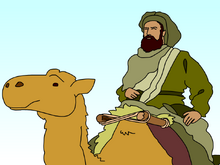| Marco Polo | |||
|---|---|---|---|
 Tim playing Marco Polo in his pool. | |||
| Airdate | April 29, 2017 | ||
| Curriculum | Social Studies | ||
Marco Polo launched in BrainPOP Social Studies April 29, 2017.
Summary[]
Tim is playing Marco Polo in the pool blindfolded and Moby lets him walk into their pool wall.
In the end of the movie, Moby offers him the blindfold. Tim says "There is no way I'm gonna put that back on.".
Appearances[]
Transcript & Quiz[]
- Marco Polo/Transcript
- Marco Polo/Quiz
FYI comics[]
Trivia[]

The Silk Road granted the Polos safe passage from Italy to the Far East and back. Check out more interesting facts about one of history's most important trade routes:
- For most of its 2,000-year history, the Silk Road didn't really have a name. The term "Silk Road" was coined in 1870 by German geographer Ferdinand von Rich t h o f e n.
- The Silk Road introduced a number of remarkable Chinese inventions to the West, including silk, paper, gunpowder, and the compass.
- Some of the spices traded along the Silk Road—including cinnamon, nutmeg, and saffron—were worth more than their weight in gold!
- While crossing Central Asia's Taklamakan Desert, many Silk Road travelers perished from thirst or hurricanes, or by losing their way between oases. The desert earned such a deadly reputation that its name is widely believed to mean, “Go in and you will not come out.” In reality, "Taklamakan" is probably derived from an Arabic phrase meaning "abandoned place."
- Most traders didn't travel the whole 4,000-mile route. Goods would be sold at stations along the way to people called "middlemen." With each sale, a middleman would raise the price. No wonder businesspeople today often aim to "cut out the middleman!"
- Under the Trans-Asia Railway Network Agreement, signed in 2006, 17 Asian nations are working to link up railroads to form an unbroken line between the Mediterranean and coastal China. The project, nicknamed the Iron Silk Road, will include 50,000 miles of railroad by its completion.
- Many historians believe that Silk Road traders might accidentally have brought the Black Death to Europe. The disease killed up to 60 percent of the European population in the 1300s!
Laws And Customs[]

To speed the passage of travelers on official business, the Mongol government issued special badges called pa i z a. In addition to protecting a traveler's safety, a pa i z a entitled its bearer to fresh horses and provisions.
The Mongol administration issued two categories of pa i z a: those for government officials, and those for ordinary people sent on special missions. Marco Polo was given the second kind to ease his way home to Venice.
The pictured specimen would have been the type carried by Marco Polo. Dating from China's Yuan Dynasty, it is inscribed in silver with Ph a k pa script, a kind of writing invented for the Mongol language. Translated, it reads:
By the strength of Eternal Heaven, an edict of the Emperor [Khan]. He who has no respect shall be guilty.
Like many special privileges, these "golden tickets" sometimes invited corruption. Officials and nobles often issued p a i z as as favours and many recipients would make abusive demands of civilians. In response, O g e d e i Khan, who ruled the Mongol Empire from 1229 to 1241, revoked the nobility's power to hand out the plaques. Il k h a n G h a z an, whom ruled from 1295 to 1304, instituted additional reforms to curb misuse.
Did You Know[]

The Mongol Empire is most famous for its conquest of huge swaths of territory. But military prowess is only part of what made it one of the greatest empires in history. Here are some other fascinating features:
Postal System: The Mongol Empire featured one of the world's most reliable and efficient communication networks. Called "Yam," meaning "route," the extensive network of relay stations allowed messages to be carried swiftly across enormous distances. At its peak, China alone featured more than 1,400 stations! A letter sent from Beijing could travel to an outpost on the other side of the continent‚ 5,000 miles in all, in about four weeks. 500 years would pass before any other postal system in the world could compete.
Warrior Queens: Mongolian women had far more power than their European counterparts. While most Mongol warriors were men, women became warriors, too. Some served as governors of large areas. One of the strongest was Man d u k ha i, who fought to reunite the Mongol tribes in the late 15th century, long after the Empire had fallen. While planning and executing battles, Man d u k h a i was also raising 10 children! All later Mongol nobility are her descendants.
Religious Tolerance: As the Mongol Empire expanded, it included regions populated by Christians, Muslims, Buddhists, and Confucians. The Mongols allowed their conquered subjects to worship as they pleased, and to keep their own religious traditions and rituals. Mongolian tolerance helped keep the vast and sprawling empire stable and peaceful. During the same era, western Christians were waging brutal wars, known as the Crusades, against Muslims.
Paper Money: Hundreds of years before the Europeans, the Mongols created a standardized system of paper currency. Chinese merchants pioneered the practice in the 10th century. This early money functioned similarly to ours: It could be traded for goods and was difficult to counterfeit. Soon, government banks began issuing the notes. When the Mongol Empire annexed China in the mid-13th century, it adopted its innovative monetary system, too.
In Depth[]

In the late 13th century, Italian romance writer da Pisa was in prison. Likely captured during a battle between his native Pisa and Genoa, he would find unexpected fame in his misfortune. In 1298, he was joined by a new inmate: a Venetian whose stories were almost too wild to believe. The man claimed to have completed a two-decade journey to the farthest reaches of the East. His name was Marco Polo.
Whether Polo's tales were true or not knew a good story when he heard one. Together, the two inmates turned Polo's account into a book: The Travels of Marco Polo.
The volume was a remarkable success, even more so considering the printing press didn't yet exist to make books widely available. Readers were wowed by descriptions of sensational creatures, terrifying cannibals, and technological innovations.
Some, like Christopher Columbus, were inspired to embark on adventures of their own. Columbus took extensive notes in the margins of his copy of Travels, and legend has it that he took it with him on his fateful journey in 1492.
Despite its popularity, Polo's book raised some doubts among readers. In Italian, it was known as Il or "The Million," short for "The Million Lies." But many of the implausible-seeming details about the Far East were simply unfamiliar to Europeans, and have since been proven true.
Still, modern scholars have found different cause for skepticism. Why, they wonder, does the narrative never mention the Great Wall of China or chopsticks? Moreover, parts of the story are contradicted by Chinese historical records. It also uses Turkish or Mongol words where Chinese words would be expected, leading some historians to believe Polo never made it to China.
Others counter that Polo's descriptions are more detailed and more accurate than other accounts of his time. They concede that Travels contains some exaggeration, but don't believe that invalidates the whole book.
Regardless of whether it's mostly fact or fiction telling of Polo's journey profoundly affected its readers. For the 1st time, Westerners were exposed to an entirely different civilization—1 with knowledge and technology far more advanced than what they knew. The European imagination of the scale of the world, both geographically and culturally, was expanded.
